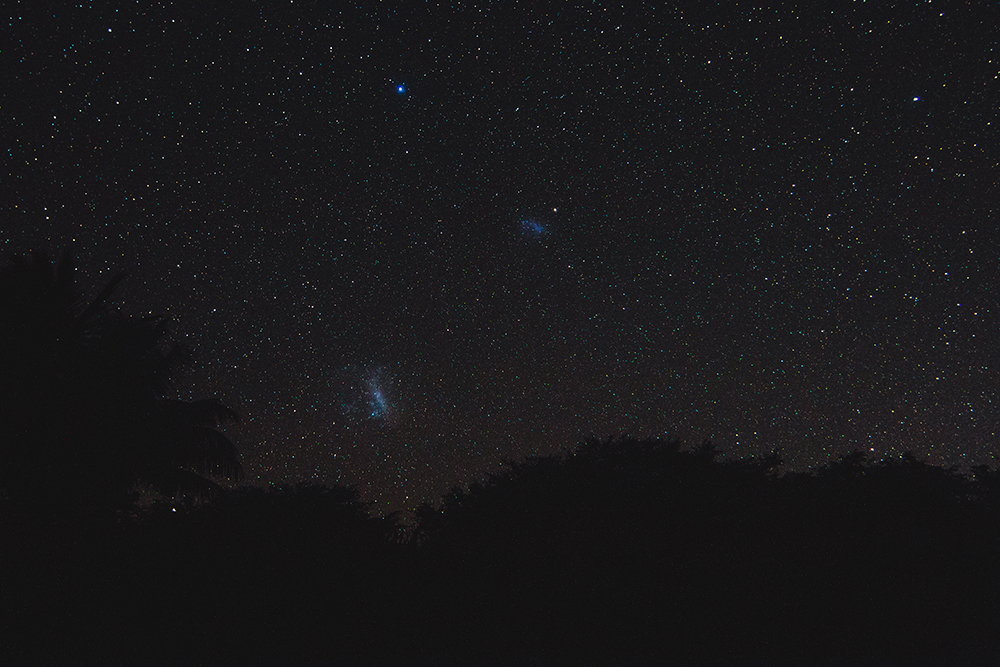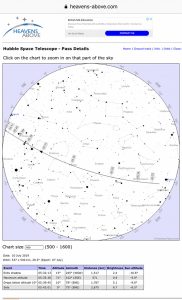The alarm on my phone sounds very similar to the clock that wakes Neo from his slumber in the Matrix. Sadly, I am not The One, especially at 1:30am. Having had less than 3 hours sleep, it was time to drag myself out of bed for another stargazing session. Quickly poking my head out the front door to check for unexpected clouds, I was greeted with a view of thousands of tiny points of light. Dressing rapidly in the dark while trying not to disturb my wife, my Takahashi FC-76 was set up on the beach in less than 15 minutes.
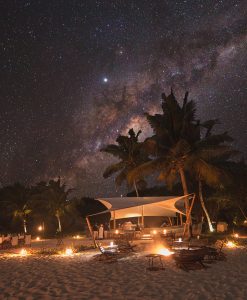
The evening before the morning session. Dinner and drinks were served most nights at the Dhow bar in the beach.
While waiting for my eyes to dark adapt to take full advantage of those Bortle Class 2 skies, I decided to start with a mini Globular Cluster marathon. First up was M4 in Sagittarius. Arguably the easiest GC to locate anywhere in the heavens thanks to its location just over a degree from the rival of Mars. Located at the heart of the Scorpion, deep orange Antares was still 25 degrees above the horizon in the west. Though not discovered by Messier, M4 was the only globular cluster he was able resolve, and hence is the first GC to be partially resolved into its component members. At lower power using the 10mm Radian (57x, 1.1o), the cluster appeared highly symmetric but a spindle of resolved stars bisect though the centre of the starry orb. Taking the power to 81x using the 7mm Nagler (0.98o field) intensified and slightly extended this crest that cuts through the middle of the cluster. The rest of the cluster was ablaze with the unresolved light of thousands of ancient suns, each tantalizing its individual presence with averted vision, but disappearing back into anonymity the moment my gaze tried to focus on it.
Just a few degrees away was another of Messiers globular clusters, M80, an easy hop from M4 and obvious in the 8×30 finder. As I studied the cluster at 81x, I chuckled as I found my mind drift to the time that Father Ted tried to explain to Dougal that “these cows are small, but those are far away,” knowing that while visually smaller and less impressive than its nearby cousin, in reality M80 is larger but more distant. The cluster is incredibly compressed at the core, with just a hint of yellowish hue which transitions to silver in the mottled halo which gradually fades from the central core to nothingness on the outer edge.
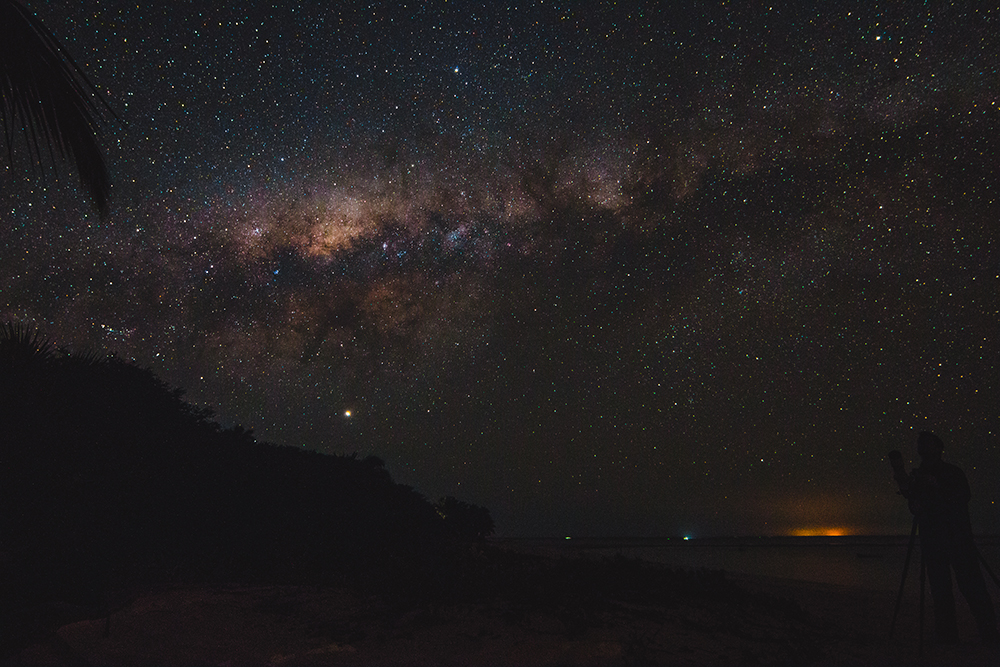
Waiting for my eyes to become fully dark adapted, but it was still an amazing sight during that time.
Switching from the slayer of Orion to the more civilised celestial teapot that is contained in Sagittarius, my next target was the brightest of all the Messier globular clusters, M22. The third brightest GC in the entire sky, only behind the mighty Omega Centauri and 47 Tucanae, this cluster is easily visible to the naked eye, just off from Kaus Borealis (Lambda Sagittarii). Staying with 81x, the cluster appeared slightly elongated, with a fairly loose core extending about 5’ in diameter, though it lacked the intensity seen in many globular clusters. A large, granular halo surrounded the core, speckling with the lights of uncountable stars when using averted vision. Most distinctive was a dark lane which sliced through the core, almost severing it in two.
Less than three degrees to the south was M28. While panning the scope to my next target, I could not resist a quick stop to take in two 9th magnitude, 5’ diameter GCs, in the form of NGC 6638 and NGC 6642. Had I switched to the 24mm Panoptic (2.7o field), I would have almost been able to view all four clusters at once. It is certainly a very busy part of the sky! In contrast to M22, the core of the cluster appeared densely packed and extended about half the diameter of the granular halo that surrounds it. The halo itself had bevelled edges which gave it a slightly square appearance rather than circular or elliptical halos of many other globular clusters.
The gas giants are not well placed for observation from the UK currently, skirting the horizon and all the muck and turbulence that brings with it. I had some what neglected the planets in previous sessions so decided to switch to higher power with the Nagler Zoom (95x-190x, 0.51o-0.26o) and turned my attention to the ringed-wonder, Saturn. Many astronomers favourite, including my own, it holds an even more special place for me as I proposed under incredibly dark Namibian starry skies with a scope pointed at the distant world. At an altitude of 58o, the planet presented a sharp view at 95x, so I quickly ran up the click stops on the zoom to 4mm (143x). Several subtle hued bands were seen on the disc, and rings, orientated north-to-south showed some delicate colour variation and the Cassini division was quite obvious. Almost directly south of the planet was the giant moon Titan.
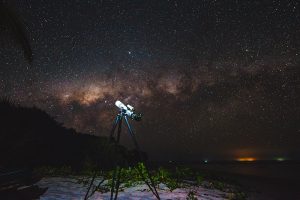
The Takahashi FC-76 waiting patiently for an observer to continue the marathon session around the sky.
At a still respectable 27o altitude was Jupiter. Despite the lower altitude I was able to maintain the same power and there was quite a lot going on. In addition to several cloud bands, showing subtle brown and coffee hues, as well as some festoons and small storms, the Great Red Spot was minutes away from transiting. Visually at least, the massive hurricane has not been worthy of that name for some time, but I was able to detect a slight salmon-pink colour in the storm. However, Jupiter was not quite done being a spectacle, as a small inky black shadow cast by Europa was 2/3 across the disc of Jupiter as well.
Before moving on to some of intended target list for this session, I could not resist taking in some of the nebulae that pepper the central region of the Milky Way. Screwing in my 2” UHC filter into the mirror diagonal, I dropped down to 57x and aimed for the Lagoon Nebula, M8. The chasm of dark obscuring material that cleaves the nebulae in two stood in stark relief to the glowing robes of hydrogen, creating the impression of two nebulae side by side. One half has just a sprinkling of bright stars nestled in the gas that birthed them, but the other side was dominated by the open cluster NGC 6530.
I then switched up to 81x and nudged the scope to centre M20, the Triffid Nebula. The multiple dark lanes that bisect the emission nebula really drew my eye, standing out far more than in past sessions without the UHC. However, the reflection nebulae which sits just off the ionised gas was hidden from view, and the small open cluster at the centre of the nebula had lost some of its lustre with the selective bandpass of the UHC.
Continuing the stellar nursery theme, my next target is one of the most famous in the sky thanks to the wonderful “Pillars of Creation” photo taken by Hubble so many years ago. Having viewed this object many times before using the 76mm Tak, I have often found the delicate robes of gas quite hard to observe, with the view of open cluster at the heart of the Nebula, NGC 6611 stealing the show. However, the UHC really helped to tease into view the nebulous material.
Just a couple of degrees away from the Eagle is the second brightest emission Nebula in Messier’s catalogue after the Orion Nebula. The UHC only added to an already impressive view. The central bar, often seen as the body of a swan drew the eye thanks to its intensity, though the loop of gas at one end of the bar that delineates the neck and head was not far behind.
Before changing course and hunting down some of the southern Jewels that never clear the horizon from the UK, I could not help but be drawn to another bright condensation in the Milky Way, a little east of the tail of Scorpius. Unsure what I would find in the eyepiece, I removed the UHC and switched down the 24mm Panoptic. Sitting on top of a very dense region of the Milky Way was a beautiful open cluster, showing a random distribution of stars. The entire cluster seemed to be embedded in a glowing, grey nebulosity. A quick review of Sky Safari identified this cluster as NGC 6193 (C83) in Ara, and the accompanying photo in the description showed beautiful glowing robes of hydrogen wrapping around the cluster members (NGC 6188). However, reading further literature on the cluster the next day indicated that the nebulosity is very hard to see, and has left me wondering if the light of countless background stars masqueraded as the nebula. I wish I had left the UHC in on the first inspection of the object.
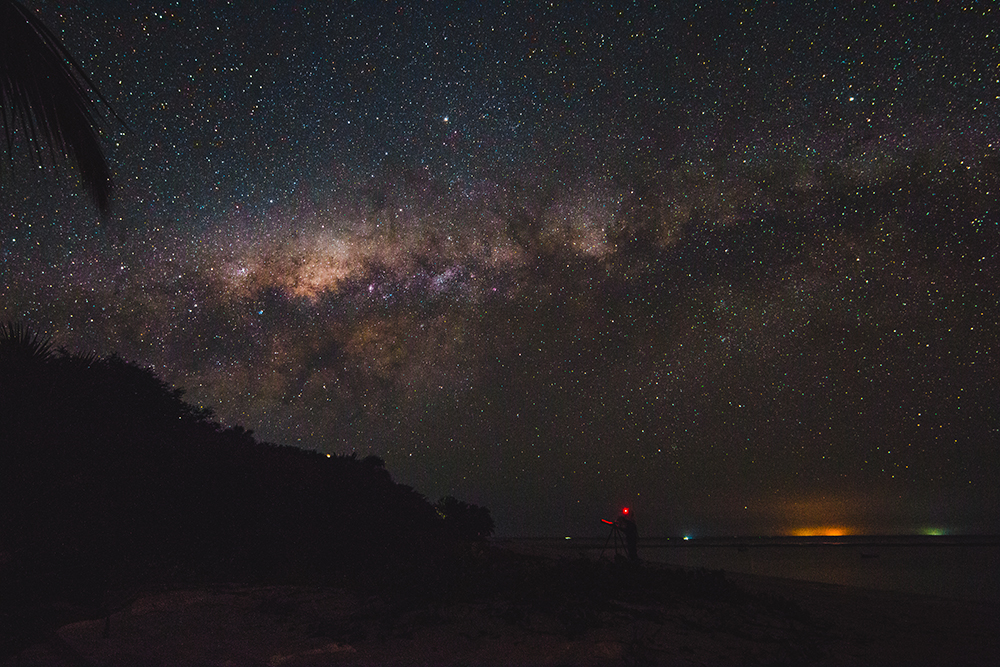
I set the camera up taking multiple exposures during this session. I must have been switching EPs during this exposure.
My first target was in the dim constellation of Horologium the clock. However even under these skies it was somewhat difficult to pick out, so I used the Eridanus the river. Starting at the head of the constellation with the star Achernar (Alpha Eridani) and the followed the meandering path of the flowing water down to Acamar (Theta1 Eridani) before panning 14o directly west to hit NGC 1261 (C87). Discovered by James Dunlop in 1826, at 24x the small cluster appeared somewhat nebulous with a slight increase in brightness to the centre. Switching to 81x really helped to bring this distant globular to life. Extending to about 5’, the core was highly compressed with some apparent lumps, surrounded by a slightly mottled and fractured halo.
Next up was another James Dunlap discovery. Similar to Centaurus A (NGC 5128) in morphology, a large elliptical galaxy which has numerous dark dust lanes which are thought to be the remnants of a spiral galaxy that merged with Fornax A in the last hundred million years. I swept back to Acamar, and then placing it on the edge of the finder with an extra nudge south west brought NGC 1316 (C13) into view. Switching to the 5mm setting of the Zoom for 114x, the nucleus of the galaxy was like a bright searchlight pointed straight at me, surrounded by an inner mottled ellipse with a small rectangular structure aligned with the major axis of the outer hazy envelope which extended to about 5’. Just off the edge of the galaxy was a smaller spherically shaped galaxy perhaps 2’ in diameter with some hints of lumpiness across one axis. This galaxy is in fact Caldwell 14 which I think is quite surprising. The only remarkable aspect of this one seems to be that it is NGC 1317 and 1318 thanks to a mistake by Julius Schmidt.
Intent on exploring a bit more of the Fornax galaxy group, but having a similar issue as Horologium in that the constellation is faint, I started once again at Acamar. Panning one finder width east revealed Beta Fornacis which was my starting point for Caldwell 67 (NGC 1097). Using the 24mm and placing Beta on the edge of the field resulted in my target coming into view on the other side of the field. A mass of around 200 billion solar masses and diameter of approximately 120,000 light years puts NGC 1097 into a similar league as the Milky Way. Switching back to the Zoom and the 4mm setting for 143x, the core appeared enveloped in a smaller inner spiral structure, more prominent on one side with hints of bar running across the long axis. That bar extended beyond the inner structure in both directions before curling back slightly on itself towards the edge of the halo’s glow. I did not spot NGC 1097A, a small satellite galaxy of C67, but perhaps not surprising at magnitude +13.6.
Switching track and returning briefly to the Milky Way, my next object stands in stark contrast to the lack of bright stars in Fornax, being a rather bright planetary nebula in that very same constellation. Once again sweeping down Eridanus, this time to mag +4.6 Tau8 Eridani, I placed the star at the bottom of the field of the finder, which put NGC 1360 in the field of my 24mm. Lying only 700 light years distant, even at such low magnification, this PN was obviously non-stellar. Unsurprising given it appears 5x larger than M57! Taking the power up to 81x was incredibly rewarding. Two arcs of material appeared to circle the luminous central star, superimposed on the rather bright, oval-shaped, amorphous glow of material. Further inspection revealed small knots around the outer edge of the nebula. It really does a rather good impression of a face-on spiral galaxy. I could not resist a quick peak with the UHC in-situ, and this only improved the view still further. I think this may well be the most impressive planetary nebula I have ever had the good fortune to observe.
I had one more target in Fornax before moving on, but once again needed to engage the warp drive to leave the confines of the Milky Way and head out into intergalactic space. Before the trip to Mozambique, I prepared a list of priority objects to observe, and NGC 1365 was near the top of the list. Why? Not only it is the brightest galaxy in the celestial furnace, but it is the most prominent barred spiral galaxy found anywhere in the heavens. Another 4th magnitude star in Eridanus was my starting point, this time h Eridani. Offsetting this star in the 24mm resulted in my target entering the field. Quite impressive even at such a low magnification, and ignoring the dozen or so galaxies also in the field, I switched up to the 6mm setting of the zoom, before increasing to 5mm to bring out a bit more detail. It was an amazing sight. The nuclear region was slightly less than one-third of the diameter of the galaxy, with an incredibly prominent bar extending almost equally away from this central core, before both ends peeled away in delicate sweeping arcs. I also felt there was hints of inner arcs near the central bar of the galaxy.
Staying extra-galactic, I moved onto Sculptor and its retinue of resplendent galaxies. Using Ankaa (Alpha Phoenicis), my first stop was edge-on barred spiral NGC 55 (C72), just about 4o away. At 81x the view was incredible. Appearing almost as a child would draw a comet, a bright offset core and coma on the leading edge, extending into a long, wispy tail in the opposite direction. Across the surface was a criss-cross of dark strands of material and some obvious mottling in the tail.
Caldwell 65 (NGC 253) is the brightest galaxy in the Sculptor and among the brightest in the entire sky. Known as the Silver Coin, it was almost like the Titanic came careering into the field as I panned from Alpha Sculptoris. It must have knocked Caroline Herschel’s socks off when she discovered it in 1783. The core region was highly mottled, extending to numerous streamers with almost no separation on the long axis. It was possible to trace out the two major spiral arms along the leading and trailing edge of this incredible galaxy. I think it is fair to say this is the most impressive galaxy I have observed and all astronomers should have it on the observing bucket list.
Remaining in Sculptor, but using Beta Ceti as a hop off point, the next galaxy on my tour was NGC 247 (C62), barely three degrees away. At 81x, the core immediately drew the eye, surrounded by a coma which showed some lumpiness, hinting at the structure revealed in long exposure photographs. The outer reaches of the galaxy extended to perhaps 15’ and with patience showed elements of the arms of this spiral galaxy along with some dark streamers and clumps of dust. While not quite the match of its nearby cousin, still one of the most impressive island universes found in the night sky.
Pointing at the zenith with an Alt-Az mount is never fun for the neck, so my timing for the Helix Nebula in Aquarius (C63 / NGC 7293) was not great, with the large planetary nebula at more than 83o above the horizon. Fortunately, first magnitude Fomalhaut was at the same altitude and lies only about 10o away, which made it a relatively easy hop. Knowing how low the surface brightness is, I used my UHC and restricted my magnification to just 57x. This was definitely an object that required some patience to tease out the finer details. The denser inner ring was brighter but did not quite complete a full circle. The fainter outer loop was very fractured though along one edge there was a denser clump which appeared like a bow shock, as though the nebula was flying through dense interstellar matter that was building up in front of it.
Something I had been waiting to revisit all holiday as it is one of my favourite DSOs, is the spectacular globular 47 Tucanae, which was now almost 40 degrees above the horizon. Just hanging off the edge of the SMC, this globular was more impressive in my 30mm finderscope than some Messier GCs appear in the actual telescope. The core was incredibly compressed and bright, almost as though a celestial lighthouse shined directly into the eyepiece. The outer envelope was very extensive with a tremendous amount of mottling and graininess. Across the envelope were several arcing streamers of stars, appearing like a spinning Catherine Wheel. I also took a quick peak at nearby NGC 362. Just like M92, the slightly neglected cousin of the Great Globular M13 in Hercules, both in that neglect and appearance, NGC 362 was a still an impressive sight.
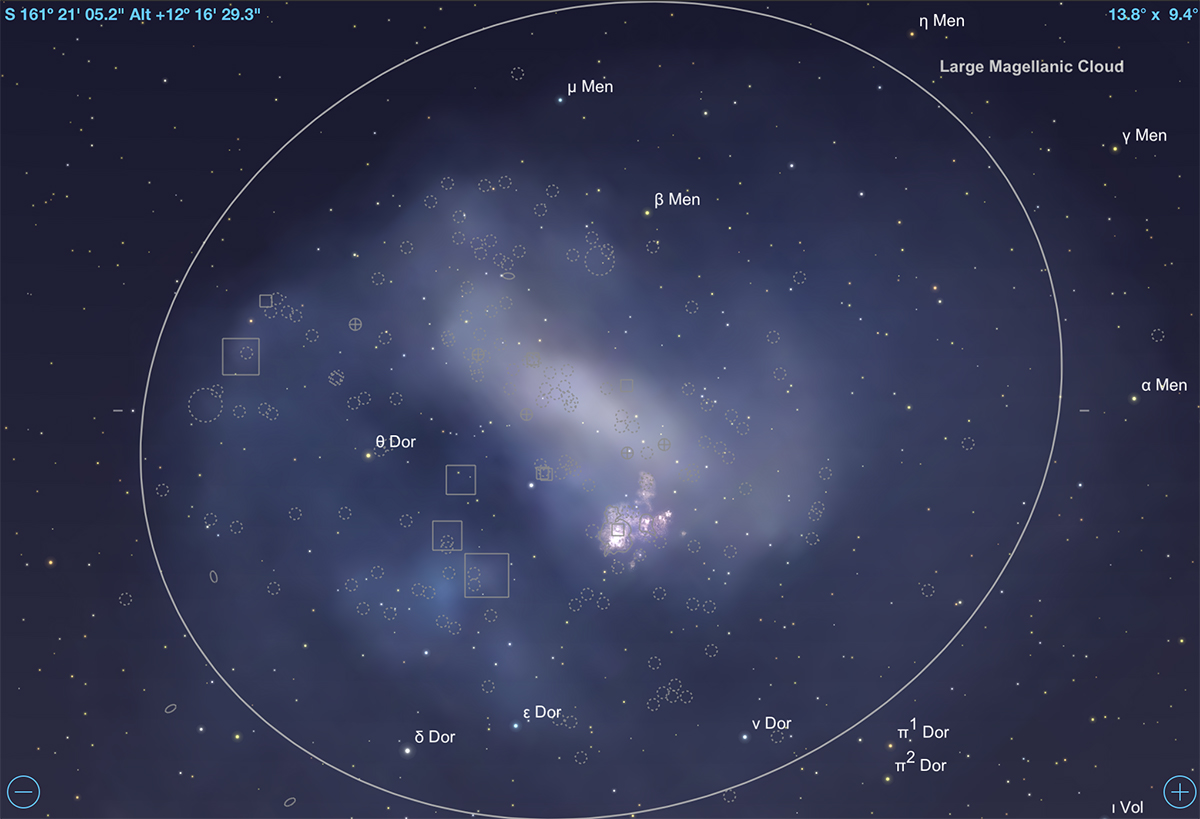
The LMC is packed with DSOs. This chart shows all DSOs to magnitude +12.5. Credit: Sky Safari 5 Pro.
Aware I had about an hour of true darkness left, I moved onto the LMC. The Milky Way’s larger satellite dwarf galaxy is home to the largest star forming region known, NGC 2070 (C103). Were this nebula located at the same distance as M42, it would appear as large as the constellation of Orion and cast shadows. Using the 7mm, the central half of the field was filled with glowing steamer of gas curling back on themselves, almost as though looking on the underside of a giant spider with its legs reaching out towards the eyepiece. The outer reaches of the nebula showed wisps and patches of nebulosity that appeared to have broken away from the main body of the nebula.
The LMC is packed with DSOs that can at least be detected with modest telescopes. The fact that one can observe nebulae and clusters in another galaxy is rather compelling and I spent a good 25 minutes just panning around the irregular dwarf picking out clumps and hazy patches of light. While most objects glimpsed remained anonymous, NGC 2014 actually had some definitive shape and structure and was easy to identify. An emission nebula extending more than 1,300 light years across is certainly a rather impressive object!
Over the last couple of hours, I had noticed almost a dozen bright meteors with persistent tails, though no obvious origin point. While looking up and wondering if another would appear, my eyes were drawn east to a rising pillar of triangular ghostly light. I was now definitely on borrowed time.
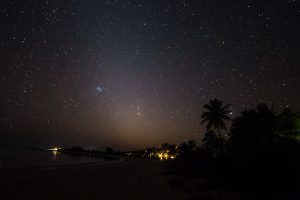
The approaching dawn was flagged by the giant pillar of ghostly light stretching up in the sky to the East.
An object I had never viewed before in Columba but had made it on to my must-see list was NGC 1851 (C73). Starting at Wazn (Beta Columbae), I panned up to Phact (Alpha) before centring Epsilon Columbae. Then placing that on the edge of the finder field and a slight nudge more brought this distant globular into view. The core of the GC was quite intense but very small, and appeared surrounded by a smaller outer envelope. The halo was quite irregular with two wing-like structures on opposite sides. Across the face, several brighter cluster members were visible.
Staying with globular clusters, next up was M79 in Lepus, an unusually located GC, in the opposite celestial hemisphere from the galactic centre. A blazing core was surrounded by an out envelope that took on a five-point star motif shape, with some granulation across the surface.
By now Canopus had cleared the trees to the south which meant that Rigel was also at around the same altitude of about 15o. This meant M42 was in play. It is not often a mid-July viewing of the Orion Nebula is on offer so I could not resist a quick peak, despite only being about 10-degrees up. The distinctive wings pealing away from the blazing core of the nebula were very impressive, especially considering the altitude as well the four primary members of the trapezium. While in Orion I could not pass up a shot at the Flame Nebula, but with some moisture in the air and a 7o altitude, it was a step too far and remained hidden from view.
With the imminent arrival of astronomic dawn, I sped rapidly around the sky taking in as many objects as possible including M45, M31 and M33, open clusters M34 and NGC 752, as well as the Little Dumbbell (M76) and my favourite double star Almach.
My intention to stargaze until a rising Sun had stolen all the stars away from me, was not just to maximise my time under these fabulously dark, skies rarely explored, but because I had a specific target I wanted to attempt once again but would not clear the horizon until 5:32am. Civil dawn had begun only a few minutes before, but fortunately my quarry was not a DSO, but that most famous eye on the Universe, the HST. Never clearing the horizon from the UK, I always make sure to watch Hubble soar across the sky if I am far south enough to see it. However, on my last two trips to the Southern Hemisphere, I have actually attempted to observe some structure in the space telescope at a relatively high magnification. Those attempts have been hindered due to a slightly wobbly tripod and a birdwatching head which has doubled as a mount for my DSLR, but the combination unfortunately induces some shakes with rapid panning of the scope. This time I specifically packed my far more rigid Gitzo GT4552TS carbon fibre tripod and a dedicated Alt Az mount in the form of the Tele Optic Giro Mini, for this HST pass.
Spotting details in the ISS is quite simple, but it is also the size of a football pitch. HST is somewhat smaller but still hefty 13.2m x 4.2m (widest diameter) excluding the solar panels. At its point of closest approach of 571km, the satellite would subtend an angular size of 4.8” x 1.5” which should be resolvable in my 76mm scope.
Stopping my DSO marathon a few minutes before the HST was due to exit the earth’s shadow, it would appear at an altitude of 15o, not far from Saturn, making the initial pick up easy. I decided to use the 7mm Nagler at 81x as I feared the narrower field of the Zoom EP would increase my chances of losing the observatory as it passed overhead. Quickly picking up the brightening point of light, I trained the telescope on target and tracked it smoothly across the sky. As the HST approached maximum altitude of 71o, I had the distinct impression of an elongation on one axis but at magnitude +0.9, it was also proving quite bright, potentially hiding any additional detail from view. Shortly after passing overhead, I briefly lost view of it, but as it was rapidly moving into a bright sky, I abandoned any further attempts to tease further detail, happy that I had discerned some structure. I span my scope back to 47 Tucanae and watched it slowly disappear from view, unsure when I would next travel south and observe it again.






